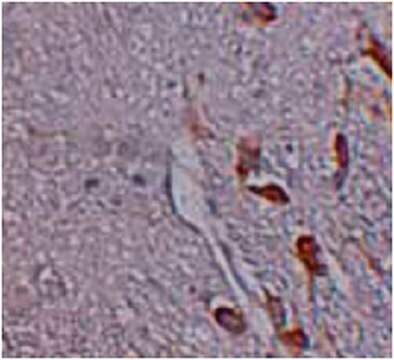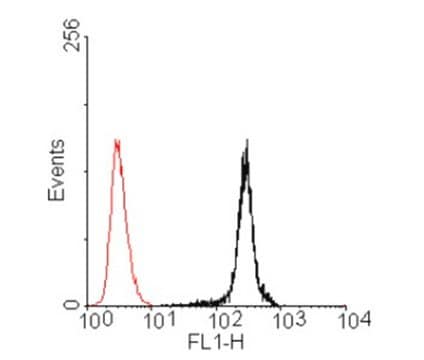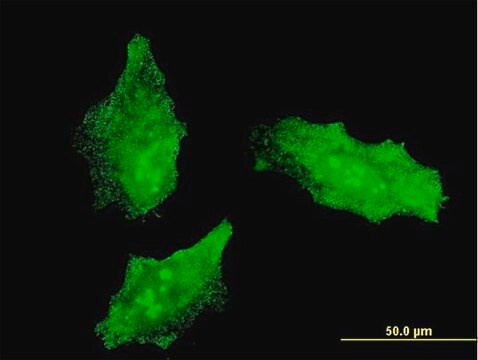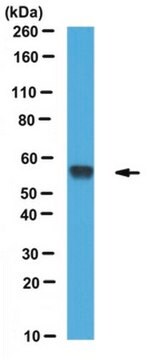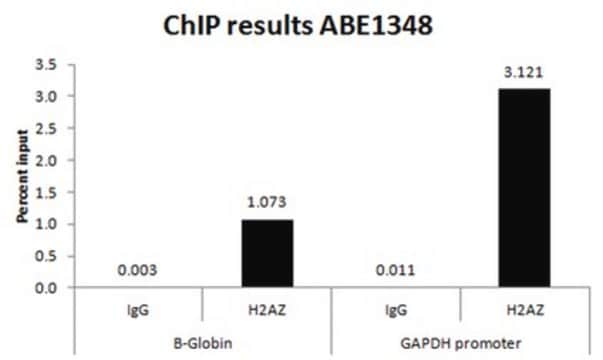General description
Zinc finger protein GLI2 (UniProt: P10070; also known as GLI family zinc finger protein 2, Tax helper protein) is encoded by the Gli2 (also known as THP) gene (Gene ID: 2736) in human. Gli2 belongs to the family of Gli C2H2-type zinc-finger proteins and contains 5 C3H2-type zinc fingers. Its N-terminal domain confers transcriptional repressor activity, while the C-terminal domain mediates transcriptional activation. Transcriptional activity of Gli proteins is also regulated through its binding to Suppressor of Fu (Sufu), which is a negative regulator of Hedgehog signaling in Drosophila as well as in vertebrates. Sufu binds to all three Gli proteins with different affinities. Phosphorylation of Gli2 by DYRK2 is shown to block its transcriptional activity and promotes its proteasomal degradation. Gli2 is reported to be essential for normal embryonic development. Gli2 affects ventroposterior mesodermal development through its regulation of Wnt, Brachyury and Xhox3 gene families. Knockout studies have shown that Gli1 can compensate for Gli2, but replacement is not perfect and is context dependent. Gli2 null mice embryos develop neural tube defects and double knockout Gli1 and Gli2 mice display serious central nervous system and lung defects. Overexpression of Gli2 has been linked to tumorigenesis and can lead to basal cell carcinomas. Mutations in Gli2 gene have been linked to holoprosencephaly 9 that is characterized by failure of forebrain to correctly separate into right and left hemispheres. Gli2 gene mutations are also known to cause Culler-Jones syndrome that features pituitary dysfunction, syndactyly, hypothalamic hamartoma, and visceral malformations.
Specificity
This polyclonal antibody detects Gli2 in mouse brain. It targets an epitope within 12 amino acids from the N-terminal half of isoform 5.
Immunogen
KLH-conjugated linear peptide corresponding to 12 amino acids from the internal edge of N-terminal region of Human Gli2.
Application
Anti-GLI2, Cat. No. ABN2241, is a highly specific rabbit polyclonal antibody that targets Zinc finger protein GLI2 and has been tested in Immunohistochemistry (Paraffin) and Western Blotting.
Immunohistochemistry Analysis: A 1:250 dilution of this antibody detected GLI2 in human pancreas, human cerebral cortex, and rat testis.
Research Category
Neuroscience
Quality
Evaluated by Western Blotting in mouse brain tissue lysate.
Western Blotting Analysis: 2 µg/mL of this antibody detected GLI2 in 10 µg of mouse brain tissue lysate.
Target description
~170 kDa observed; 167.78 kDa calculated. Uncharacterized bands may be observed in some lysate(s).
Physical form
Affinity Purified
Purified rabbit polyclonal antibody in buffer containing 0.1 M Tris-Glycine (pH 7.4), 150 mM NaCl with 0.05% sodium azide.
Storage and Stability
Stable for 1 year at 2-8°C from date of receipt.
Other Notes
Concentration: Please refer to lot specific datasheet.
Disclaimer
Unless otherwise stated in our catalog or other company documentation accompanying the product(s), our products are intended for research use only and are not to be used for any other purpose, which includes but is not limited to, unauthorized commercial uses, in vitro diagnostic uses, ex vivo or in vivo therapeutic uses or any type of consumption or application to humans or animals.
